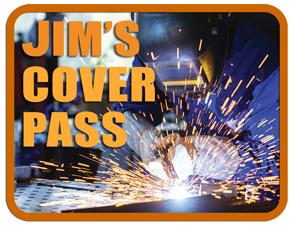Senior Company Trainer
- FMA
- The Fabricator
- FABTECH
- Canadian Metalworking
Categories
- Additive Manufacturing
- Aluminum Welding
- Arc Welding
- Assembly and Joining
- Automation and Robotics
- Bending and Forming
- Consumables
- Cutting and Weld Prep
- Electric Vehicles
- En Español
- Finishing
- Hydroforming
- Laser Cutting
- Laser Welding
- Machining
- Manufacturing Software
- Materials Handling
- Metals/Materials
- Oxyfuel Cutting
- Plasma Cutting
- Power Tools
- Punching and Other Holemaking
- Roll Forming
- Safety
- Sawing
- Shearing
- Shop Management
- Testing and Measuring
- Tube and Pipe Fabrication
- Tube and Pipe Production
- Waterjet Cutting
Industry Directory
Webcasts
Podcasts
FAB 40
Advertise
Subscribe
Account Login
Search
Jim's Cover Pass: Don’t let modern-day power sources intimidate you
- By Jim Mosman, AWS, CWI/CWE
- June 23, 2021
- Article
- Arc Welding

Jim Mosman compares the bells and whistles on modern welding power sources to the infinite number of channels available on cable television. While they are convenient and useful to some, he still tends to fall back on his favorites. Getty Images
Q: I haven’t welded in several years. I just purchased a new welding machine and it has more buttons and menus than my TV remote. Where do I start?
A: Much like television, welding power sources have evolved over the years. When I was young—no, I am not going to mention my age—my parents had that beautiful TV console with the record player and speakers all in one unit. We received four local channels in black and white that went off the air at midnight. And, yes, I was the family remote in charge of changing the channel.
About that same time, I started using the old Lincoln Electric AC 225 machine we had on the farm. You turned it on, cranked up the amperage, and burned up some E6011 rods trying to fix farm equipment. One process was available, SMAW using AC, and we used only 1/8-in. electrodes. Looking back, that was the beginning of my almost 50 years in this welding industry.
I currently have several televisions in my house, and my cable listing has several hundred channels I can choose to watch 24 hours a day. I have to admit, though, that I usually watch only three or four of my favorite channels. Sometimes every member of my family is in a different room watching a different channel or program depending on our personal tastes and interests.
Along those same lines, the welding power sources I now use on the job also have several hundred welding programs available. I have taken the time to scan through all of them and have even tried out several, but—you guessed it—I tend to use my three or four favorite ones.
Most of the multiprocess welding power sources currently available have multiple programs for you to choose from, starting with the desired welding process along with the type of metal you’re welding. Within those programs you can adjust the parameters to your personal taste or requirements as needed. Always remember to consider the basics of welding: process, base material type and thickness, current type, amperage or wire feed speed, voltage, arc length or contact-tip-to-work distance, electrode type and size, and shielding gas if required. You can input these settings on the power source, but the other variables like work angle, travel angle, direction of travel, and welding speed are all controlled by you.
I still tend to use my favorite weld settings and processes just like I tend to watch my favorite television shows. However, I appreciate the fact that I have options available when I encounter the need or desire to try something new.
Just in case you are wondering, my wife controls the remote in our living room!
About the Author

Jim Mosman, AWS, CWI/CWE
Lincoln Electric Education Division
About the Publication
Related Companies
subscribe now

The Welder, formerly known as Practical Welding Today, is a showcase of the real people who make the products we use and work with every day. This magazine has served the welding community in North America well for more than 20 years.
start your free subscription- Stay connected from anywhere

Easily access valuable industry resources now with full access to the digital edition of The Fabricator.

Easily access valuable industry resources now with full access to the digital edition of The Welder.

Easily access valuable industry resources now with full access to the digital edition of The Tube and Pipe Journal.
- Podcasting
- Podcast:
- The Fabricator Podcast
- Published:
- 04/16/2024
- Running Time:
- 63:29
In this episode of The Fabricator Podcast, Caleb Chamberlain, co-founder and CEO of OSH Cut, discusses his company’s...
- Trending Articles
Sheffield Forgemasters makes global leap in welding technology

ESAB unveils Texas facility renovation

Engine-driven welding machines include integrated air compressors

How welders can stay safe during grinding

The impact of sine and square waves in aluminum AC welding, Part I

- Industry Events
16th Annual Safety Conference
- April 30 - May 1, 2024
- Elgin,
Pipe and Tube Conference
- May 21 - 22, 2024
- Omaha, NE
World-Class Roll Forming Workshop
- June 5 - 6, 2024
- Louisville, KY
Advanced Laser Application Workshop
- June 25 - 27, 2024
- Novi, MI



























